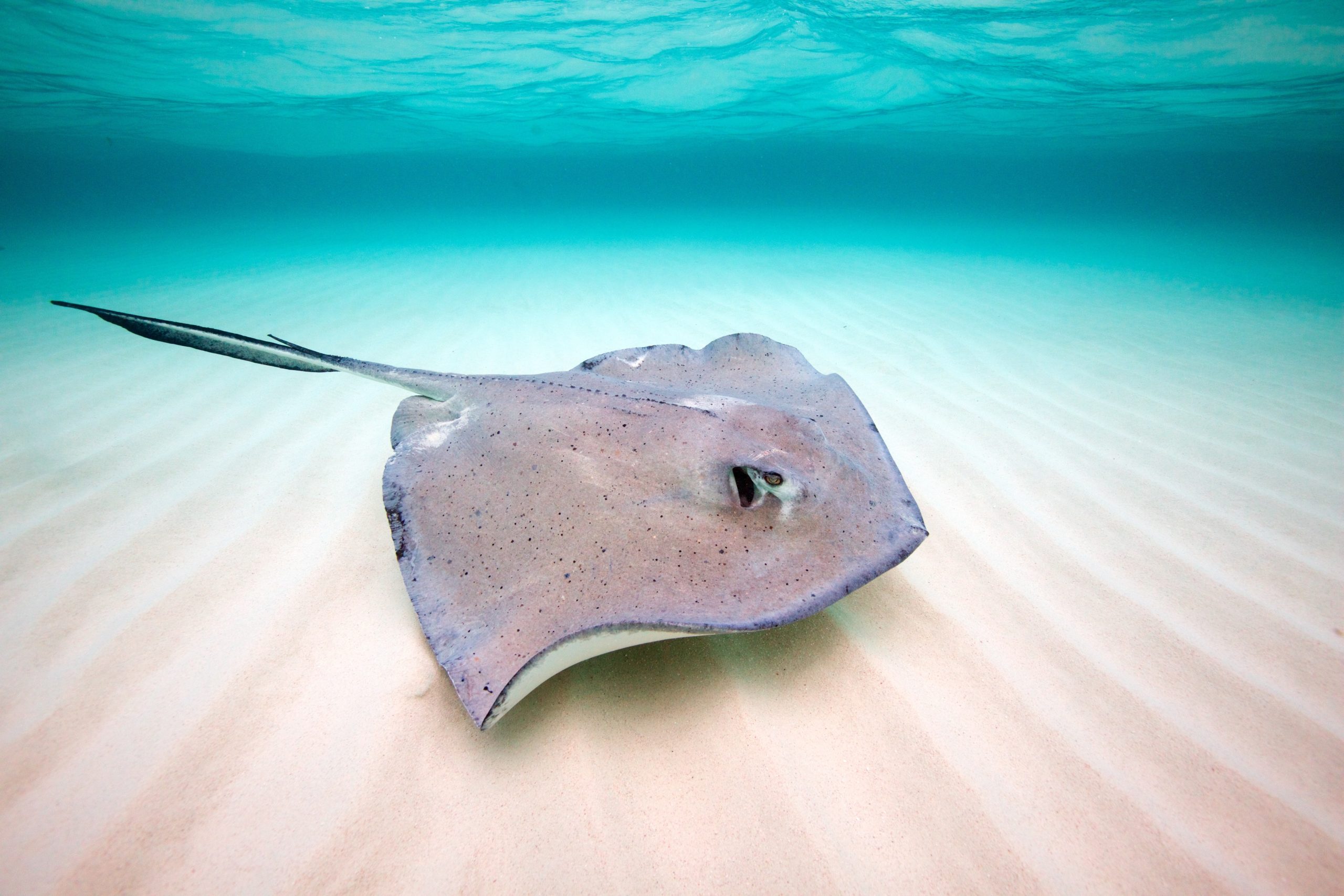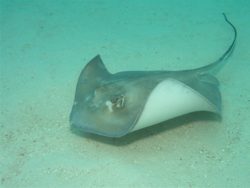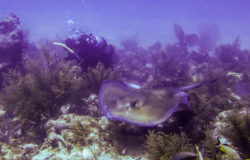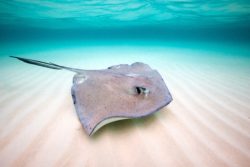
Sea Wonder: Southern Stingray
Southern stingrays (Hypanus americanus) are cartilaginous fishes that are relatives of sharks and skates. They spend most of their lives along the ocean floor, and they are perfectly equipped for such a life. Where you see southern stingrays in shallow, coastal waters, shore birds are likely to follow, taking advantage of the fish stirred up by the rays’ movements.
Descriptions
Southern stingrays have flat, diamond-shaped bodies, (also called discs) with sharp corners at the ends. This species is more angular than other species of rays. Their backs are an olive-green or brown color, which helps them blend into the sandy seabed, though juveniles sometimes have dark gray backs for a short time in their lives. Their ventral sides (bellies) are much lighter, mostly white with darker bands toward the edges. Their pectoral fins are attached to their discs and look more like wings than fins. They have two eyes atop their heads and a mouth and two sets of gills on their ventral sides. On top of their heads are small, specialized openings called spiracles, which help them breath when their gills are covered by taking water in dorsally. Male southern stingrays reach lengths of two or three feet across and females grow to be about four feet across. The long, whip-like tails can grow to be nearly twice as long as their bodies.
Diet & Habitat

Photo: Julie Bedford/NOAA/Public and Constituent Affairs
Southern stingrays are forage feeders that eat whatever they can find, even hard-shelled animals, which they can easily crush using the hard bony plates in their mouths. They commonly eat small fishes, worms, crustaceans, and mollusks. To find food, they use their sense of smell, touch, and signals picked up by their electroreceptors to find hidden prey. To reveal their food, they spray water from their mouths or forcefully flap their fins to disturb the substrate where animals are hiding.
They are opportunistic feeders, meaning they will eat whatever is available and the easiest to catch. They often hunt at night but are for the most part considered continuous foragers, grazing all throughout the day. Southern stingrays are preyed upon by large fish like lemon sharks and hammerhead sharks. To avoid predation, southern stingrays bury themselves in the sand and can use the venomous barbs on their tails to protect them.
The southern stingray’s range is limited to tropical and subtropical waters in the Western Atlantic Ocean and the Gulf of Mexico, with a northern range of New Jersey and a southern range of southern Brazil. They are often found in shallower coastal waters but can live as deep as nearly 200 feet if food is available. They are bottom dwellers and are rarely seen swimming more than a few feet about the seafloor. In the National Marine Sanctuary System, they can be found in Florida Keys, Flower Garden Banks, and Gray’s Reef national marine sanctuaries. Southern stingrays undergo short migrations to annual nurseries.
Life History
Southern stingrays reproduce via internal fertilization and give live birth after a pregnancy lasting four to seven months. Mothers can give birth to up to 10 pups per litter. From birth, southern stingrays have a serrated barb attached to their tail and are independent.
Where exactly a southern stingray population lives determines their life cycle and when they reach sexual maturity. Overall, males appear to reach sexual maturity a year or two before females, and they may live to be upwards of 15 years old. Southern stingrays can live their lives alone or form large groups, which usually occurs during mating season or as protection from predators. They seem to communicate with pheromones, touching, and biting.
Threats & Conservation
Southern stingray populations seem to be healthy and stable overall, though other stingray species are threatened or endangered. Southern stingrays were originally listed as “data deficient” on the International Union for the Conservation of Nature (IUCN) Red List but in early December of 2020 their status was updated to “Near Threatened.” Southern stingrays are often caught as bycatch, targeted for the aquarium trade, or interfered with by snorkelers and divers. They also face threats related to coastal development, climate change, deoxygenation (or ocean dead zones), and ocean acidification, which can lead to a decline in the shellfish populations they feed upon.

Southern stingray swimming at Conch Reef in Florida Keys National Marine Sanctuary. Photo: Dr. Karen Neely

